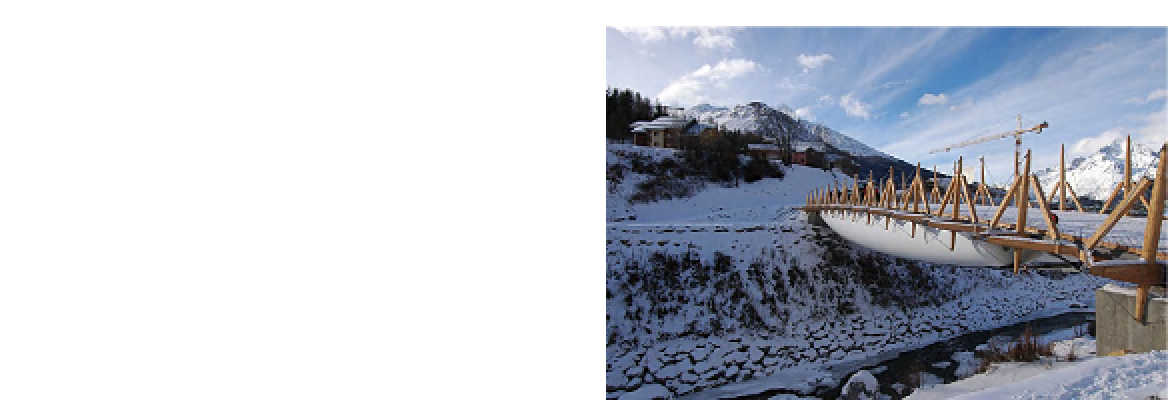Biomedical Engineering Reference
In-Depth Information
network of hollow microchannels is built up
using three-dimensional printing. The channels
are filled with a liquid healing agent and the
material is coated with an epoxy material with
embedded solid catalyst particles. When the sur-
face coating cracks under load, the liquid healing
agent wicks from the microchannels and cures
due to contact with the catalyst. The process can
be repeated.
Companies from Germany and Switzerland,
in collaboration with the University in Freiburg
in Germany, have developed a self-sealing mech-
anism that can be used in pneumatic structures
such as rubber boats and air-filled load-bearing
constructions
[38, 39]
. One example of the latter
is a bridge in the Alps that spans 52 m, as shown
in
Figure 13.10
[40]
. The bridge has two long,
tubular, low-pressure air beams (air-filled bal-
loons) with walls made of a heavy-duty flexible
membrane. The air beams are part of a
tensairity
structure in which the top side of the balloon
stabilizes the compression bar against buckling.
Wires are swept around each balloon to keep it
at a distance from the compression bar and
thereby add to the strength and stiffness. The
tensairity principle makes it possible to signifi-
cantly reduce the weight of the load-bearing con-
struction
[39, 41]
. A concern, however, is the risk
of failure due to puncture of the balloons, but
that risk can be reduced thanks to the self-sealing
mechanism. At the present time the self-sealing
mechanism is not applied in the bridge but has
been tested on demonstrator constructions.
The self-sealing mechanism is inspired by the
twining liana
Aristolochia macrophylla
. During
growth, the stem increases its diameter, thereby
causing circumferential rings of sclerenchyma
fibers to break and split into segments. To pre-
vent the fissures between the segments from
reaching the stem surface, the liana uses a rapidly
sealing operation as the first element in the self-
healing mechanism. The underlying cortex par-
enchymatous cells have a high internal pressure
called
turgor
that presses them into and closes the
fissure. This principle is mimicked using soft
FIGURE 13.10
The Lanselevillard bridge in the Alps
spanning 52 m. A very low-weight structure is achieved
using the tensairity principle where airbeams stabilize com-
pression and tension elements. Such a structure would
benefit from a self-sealing mechanism using a principle
inspired by the twining liana
Aristolochia macrophylla
. Cur-
rently, the self-sealing mechanism has only been tested on
demonstrator constructions. Photograph reproduced with
kind permisssion from Dr. Rolf Luchsinger, Empa—Center
for Synergetic Structures.
closed-cell polymeric foam on the inside of the
membrane. Internal stress is introduced into the
cells by curing the foam under pressure
[42]
.
Rampf
et al
.
[38]
explained the mechanics and
working principles of the self-sealing membrane.
Figure 13.11
illustrates the principle. A base
membrane made from PVC and polyester was
coated on the inside with polyurethane polymer
foam. The polyurethane is made in a chemical
reaction between isocyanate and polyol. Mixing
the two components results in open-cell foam
polyurethane, but applying pressure to the foam
while it cures gives a closed-cell structure. Two-
bar overpressure resulted in a solid coating
almost without air cells and therefore no sealing
effect. An overpressure of one bar gave the best
repair efficiency. The repair efficiency was calcu-
lated as the relation between airflow from a punc-
tured coated membrane and from a reference
uncoated membrane. A completely closed fissure
would result in an efficiency of 1; no reduction of
airflow would result in efficiency 0. Rampf
et al
. achieved a repair efficiency of 0.999.

